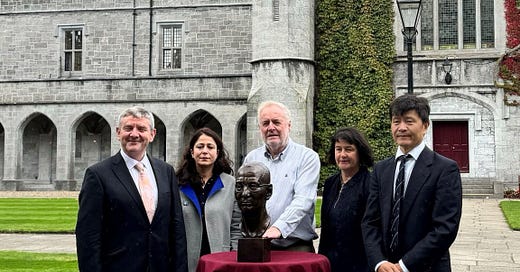On Wednesday, Human Rights in China (HRIC) and Art for Human Rights celebrated the unveiling of the world's first statue of Liu Xiaobo on a university campus at the University of Galway, Ireland. The bust, which was commissioned by HRIC and Art for Human Rights from Czech sculptor Marie Šeborová, will be permanently on display at the Irish Centre for Human Rights. This event marked a significant victory for the Chinese democracy movement and a powerful statement against authoritarianism. Speakers included university president Ciarán Ó hÓgartaigh, Director of the Irish Centre for Human Rights Siobhán Mullally, HRIC Executive Director Fengsuo Zhou, Bill Shipsey of Art for Human Rights, Barbora Bukovska of Article 19, and Professor Roja Fazaeli of the Irish Centre for Human Rights and Frontline Defenders. In addition to the unveiling ceremony, there was a one-and-a-half-hour seminar attended by more than 70 students and teachers, on human rights issues in China, Liu Xiaobo's legacy, the fate of the 1989 Movement, and the CCP’s transnational influence.
Liu Xiaobo was a brave and devoted advocate for the Chinese people. In 1989, he chose to give up a visiting scholar position at Columbia University to return to China, where he supported student protestors on Tiananmen Square. After serving 21 months for participating in the protests, he criticized the government for its policies towards Tibet and Taiwan and was sent to re-education through labor for another three years. In 2008, Liu co-authored Charter ‘08, a manifesto calling for respect towards human rights and freedoms in China, and in retaliation was jailed for “inciting subversion of state power.” In 2010, he was awarded the Nobel Peace Prize in absentia “for his long and non-violent struggle for fundamental human rights in China.” However, Liu never received his prize—in 2017, still in prison, he passed away at the age of 61. HRIC’s Fengsuo Zhou said: "From the Tiananmen protests to Charter 08, to his martyrdom in 2017, Liu Xiaobo symbolizes the peaceful struggle for freedom and democracy in China. We commemorate him by erecting his statue. His legacy will continue to inspire us all."
The journey to this moment has been challenging. Many universities worldwide, under pressure from the Chinese government, have been hesitant to host a memorial Liu Xiaobo on their campuses. The University of Galway's courage in the face of potential diplomatic and economic repercussions is commendable. Bill Shipsey, founder of Art for Human Rights, emphasized the statue's importance: "The Chinese Communist Party has tried to erase Liu Xiaobo's memory since his death in a military hospital in 2017. But his words will outlast those of any authoritarian leader and will be remembered and cherished by all who love freedom and respect human rights."
HRIC extends our heartfelt gratitude to Professor Ciarán Ó hÓgartaigh, President of the University of Galway, and Professor Siobhán Mullally, Director of the Irish Centre for Human Rights, for their unwavering support and courage in hosting Liu Xiaobo's statue. Their commitment to academic freedom and human rights, especially in the face of potential pressures, exemplifies the highest ideals of educational institutions. By providing a home for this important memorial, they have not only honored Liu Xiaobo's legacy but also reinforced the university's role as a bastion of free thought and human dignity. Their leadership sets a powerful example for academic institutions worldwide. We also extend our sincere appreciation to our partners who have made this project possible: Art for Human Rights, Article 19, Index on Censorship, Front Line Defenders, International Service for Human Rights (ISHR), and Humanitarian China. Together, we continue to challenge censorship, preserve historical truth, and champion the cause of freedom and democracy in China. This statue is not just a symbol of past struggles, but a beacon guiding us toward a more just future.
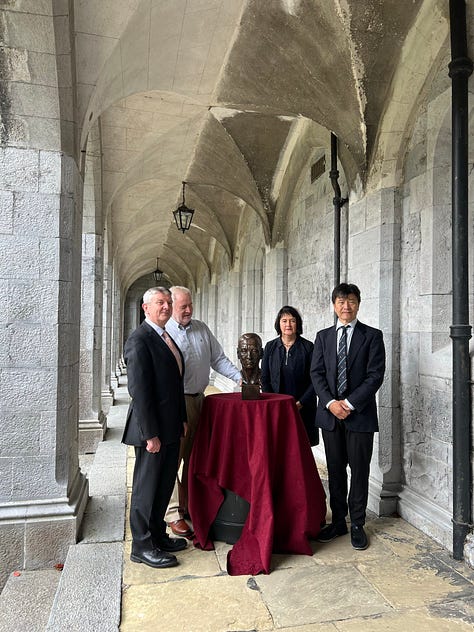
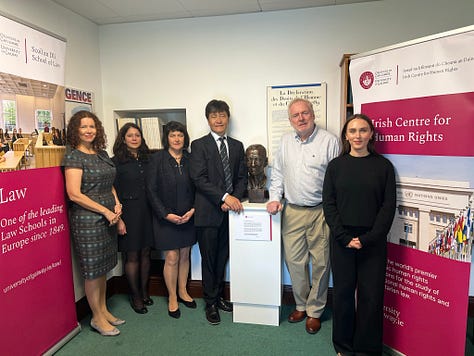
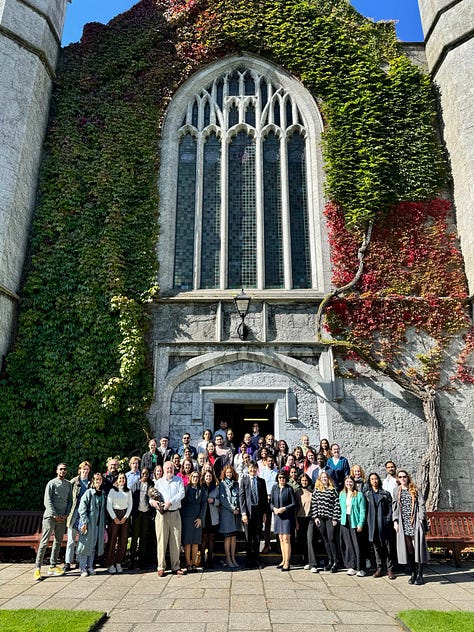
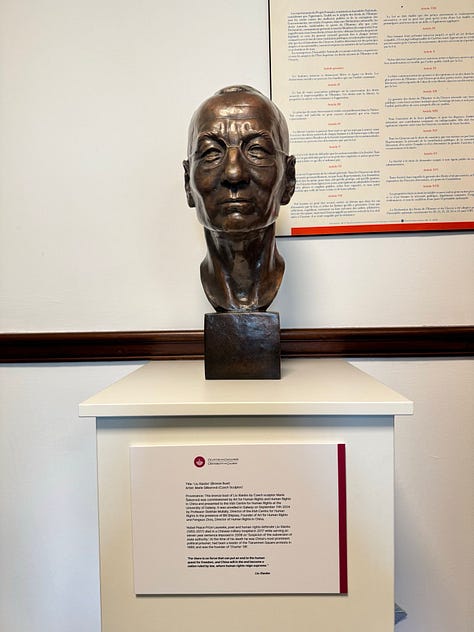
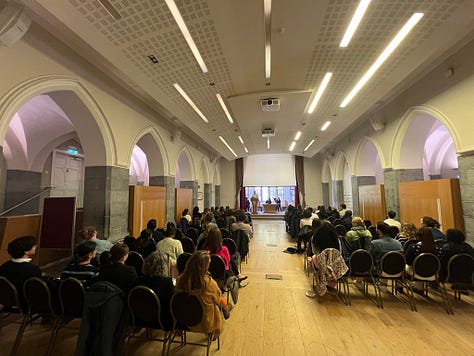
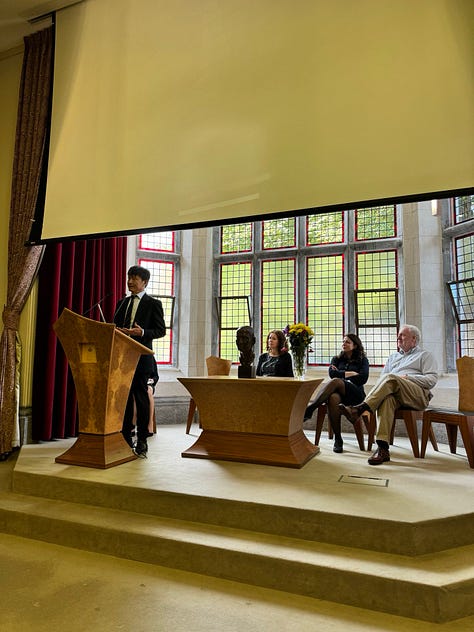
刘晓波铜像在爱尔兰高威大学落成
周三,中国人权 (HRIC) 与艺术支持人权 (Art for Human Rights) 在爱尔兰高威大学校园内庆祝了全球首尊刘晓波雕像的揭幕。这尊半身像由中国人权与艺术支持人权委托捷克雕塑家玛丽·舍博罗娃(Marie Šeborová)创作,将永久陈设在爱尔兰人权中心。此事标志着中国民主运动的一个重要进展,也是对专制主义作出的一次有力抗议。揭幕仪式的发言人包括高威大学校长基兰·奥霍加提(Ciarán Ó hÓgartaigh)、爱尔兰人权中心主任希尔凡·穆拉利(Siobhán Mullally)、中国人权执行主任周锋锁、艺术支持人权的比尔·希普西(Bill Shipsey)、第十九条组织的芭芭拉·布科夫斯卡(Barbora Bukovska)以及爱尔兰人权中心和前线卫士的罗哈·法泽利(Roja Fazaeli)教授。揭幕仪式结束后,主办方还举行了一场90分钟的研讨会,共有70多名师生参与讨论,内容涉及中国人权问题、刘晓波的遗产、八九民运的命运以及中共的跨国影响力。
刘晓波是中国人民的一位勇敢和忠诚的倡导者。1989年,他放弃了在美国哥伦比亚大学的访问学者职位,回到中国支持天安门广场上的抗议学生,因此而服刑21个月。此后,他还因批评中国政府对西藏和台湾的政策,被判处三年劳动教养。2008年,刘晓波参与了《零八宪章》的起草工作,以此呼吁当局尊重中国人权和自由,并因此被控“煽动颠覆国家政权”再次入狱。2010年,刘晓波因“长期以非暴力方式在中国争取基本人权”而获诺贝尔和平奖,但他始终未能亲自领奖。2017年,仍在狱中的刘晓波因病去世,年仅61岁。中国人权执行主任周锋锁表示:“从八九民运到《零八宪章》,再到他2017年殉难,刘晓波象征着追求自由民主的和平抗争。我们通过树立他的雕像来纪念他,而他的遗产也将继续激励我们每一个人。”
刘晓波雕像落成并非易事。由于受到来自中国政府的压力,许多大学在校内设立刘晓波纪念碑一事上都表现出了犹豫。因此,高威大学在面对潜在外交和经济后果时展现出的勇气值得赞赏。艺术支持人权创始人比尔·希普西强调了这尊雕像的重要性:“自从2017年刘晓波在国内一家医院去世后,中共就一直想抹杀世人对他的记忆,但他话语的影响力将超越任何一位独裁者,也将被世上每一位热爱和平、尊重人权的人所怀念和珍视。”
中国人权对高威大学校长基兰·奥霍加提教授以及爱尔兰人权中心主任希尔凡·穆拉利教授表示由衷感谢,感谢他们对安置刘晓波铜像的坚定支持和莫大勇气。他们对学术自由和人权的坚持彰显了教育机构的最高理想。通过为这座重要纪念物提供场地,他们不仅表达了对刘晓波遗产的尊重,也巩固了这所大学在捍卫自由思想和人格尊严上的堡垒地位。他们的领导力为全球其他学术机构树立了一个有力榜样。我们还要向所有促成这个项目的合作伙伴表示诚挚感谢,他们分别是:艺术支持人权、第十九条、审查指数、前线卫士、国际人权服务社以及人道中国。我们将继续携手挑战言论审查、捍卫历史真相,并为中国的自由与民主事业而奋斗。这尊雕像不仅象征着以往的斗争,更是引领我们迈向一个更公正未来的灯塔。

